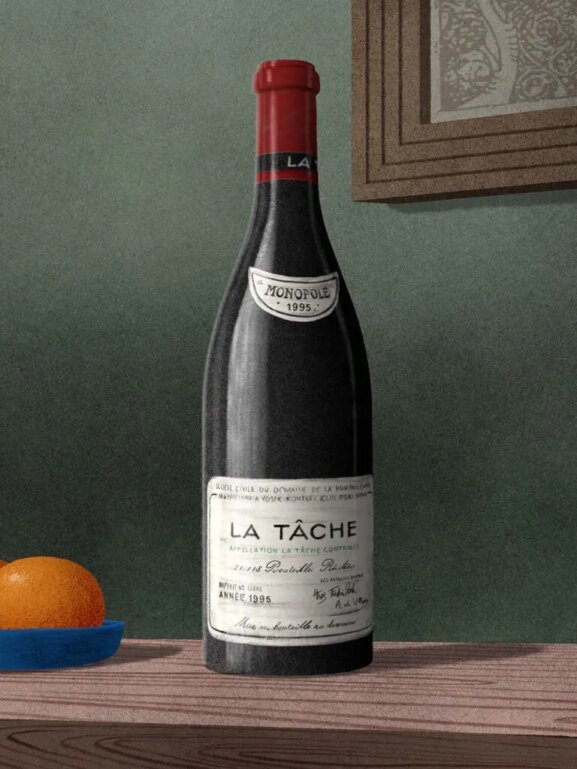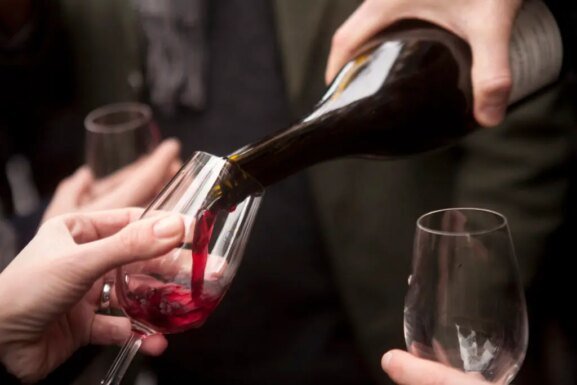Napa Valley Pinot Noir Is Planting Its Flag
Though Napa Valley’s calling card has historically been its Cabernet Sauvignon, in the early days that followed Prohibition in Napa, many premium producers tried their hand at Pinot Noir.
“All of the champions of varietal wines from the 1930s, 1940s, and 1950s persevered with Pinot,” writes John Winthrop Haeger in his book, North American Pinot Noir (University of California Press, 2004).
Among them were Inglenook, Beaulieu, Martini, Beringer, and Charles Krug.
Quality varied, however. Increasingly, Cabernet Sauvignon, suited for the valley’s relatively warm climate, took over, especially after the “Judgment of Paris” blind tastings in 1976, where some of France’s foremost wine experts rated a California Cab higher than some of the top bottles from Bordeaux.
“Bad wines, negative reviews, and consumer disaffection drove winery after winery to drop Pinot from their offerings during the late 1970s and early ’80s,” Haeger adds. “Sterling, Caymus, Freemark Abbey, Heitz Cellar, and even Louis Martini left the field.”
Most of Napa Valley was considered too hot for the thin-skinned grape.
By 2016, just 2,838 acres of Pinot Noir were in Napa. Last year? Less than 2,300.
A Refuge in Cooler, Coastal Vineyards
Nicknamed the “heartbreak grape,” Pinot Noir is notorious for being fickle and demanding. It needs constant care and attention, a climate that’s not too hot or cold, and the right combination of soils, clones, and rootstocks.
The foggy, windswept region that would eventually become the Los Carneros American Viticultural Area (AVA), just a few miles from San Pablo Bay, meets the grape’s stringent demands. The region has been home to small plantings of Pinots for decades—long before Sideways thrust the varietal into the mass spotlight.
The Carneros Pinots that have everything working together in harmony, boast flavors like “spiced red cherry” and what they call “cranberry verve,” says Wine Enthusiast Writer-at-Large and Napa Valley wine reviewer Elaine Chukan Brown. But when anything is out of balance, yields, and flavor profiles can easily go awry.
// Create the element
var script_68cf3fcb0c6f4 = document.createElement(“script”);
script_68cf3fcb0c6f4.innerHTML = `
window.googletag = window.googletag || {cmd: []};
googletag.cmd.push(function() {
var adType = “leaderboard”;
var mapping;
var lbmapping = googletag.sizeMapping()
.addSize([1024, 0], [[970, 250], [970, 90], [1, 1], [728, 90]])
.addSize([728, 0], [[728, 90], [1, 1]])
.addSize([320, 0], [[1, 1], [300, 50], [300, 100], [320, 50], [320, 100]])
.addSize([0, 0], [[1, 1], [320, 50]])
.build();; // Size mapping for leaderboard ads
var medrecmapping = googletag.sizeMapping()
.addSize([1024, 0], [[300, 600],[300, 250]])
.addSize([728, 0], [300, 250])
.addSize([320, 0], [[1, 1],[300, 250]])
.addSize([0, 0], [[1, 1], [300, 250]])
.build(); // Size mapping for med rectengle ads
if(‘/39808611/article_page/article_leaderboard_1’ == ‘/39808611/article_page/article_leaderboard_1’
|| ‘/39808611/article_page/article_leaderboard_1’ == ‘/39808611/article_page/article_leaderboard_2’
|| ‘/39808611/article_page/article_leaderboard_1’ == ‘/39808611/article_page/article_leaderboard_3’) {
mapping = googletag.sizeMapping()
.addSize([1920, 0], [[728, 90]]) // >= 1920px
.addSize([1440, 0], [[728, 90]]) // 1440px-1919px
.addSize([730, 0], [[300, 250]]) // 730px-1439px
.addSize([0, 0], [[320, 100], [320, 50], [300, 100], [300, 50], [300, 250]]) // Up to 729px
.build();
} else {
mapping = adType == ‘leaderboard’ ? lbmapping : medrecmapping;
}
googletag.defineSlot(‘/39808611/article_page/article_leaderboard_1’, [],
‘div-gpt-ad-68cf3fcb0c6f4’).addService(googletag.pubads()).defineSizeMapping(mapping);
googletag.pubads().enableSingleRequest();
googletag.pubads().collapseEmptyDivs();
googletag.display(‘div-gpt-ad-68cf3fcb0c6f4’);
});
`;
// Append the script to the body
document.body.appendChild(script_68cf3fcb0c6f4);
Carneros, whose borders extend to cover parts of Sonoma County—which boasted five times Napa’s acreage of Pinot planings last year—often contains a large section of Napa’s Pinot harvest. It’s relatively rare to taste Pinot Noir from anywhere in Napa other than Carneros. It’s evasive, but it does exist.

Napa Pinot Beyond Carneros
“People sometimes forget how complex the growing conditions from Napa Valley truly are,” says Brown. “With the cooling influence of the nightly fogs and daytime breezes, and the natural sun-shade from mountains in the area, there really are some perfect spots for Pinot Noir.”
The grape grows in a few outlying, unexpected spots high in the mountains of Atlas Peak and Spring Mountain, as well as in a few pockets of Coombsville, another relatively cool appellation southeast of the city of Napa.
Brown’s advice: “Don’t sleep on Pinot from Coombsville or Wild Horse Valley. They’re not as well known as Carneros but they get plenty of fog and wind off the Bay to do really well with the variety.”
Brie Cadman’s family makes Pinot Noir for their Tulocay label from fruit grown in Coombsville’s Haynes Vineyard.
// Create the element
var script_68cf3fcb0cc79 = document.createElement(“script”);
script_68cf3fcb0cc79.innerHTML = `
window.googletag = window.googletag || {cmd: []};
googletag.cmd.push(function() {
var adType = “leaderboard”;
var mapping;
var lbmapping = googletag.sizeMapping()
.addSize([1024, 0], [[970, 250], [970, 90], [1, 1], [728, 90]])
.addSize([728, 0], [[728, 90], [1, 1]])
.addSize([320, 0], [[1, 1], [300, 50], [300, 100], [320, 50], [320, 100]])
.addSize([0, 0], [[1, 1], [320, 50]])
.build();; // Size mapping for leaderboard ads
var medrecmapping = googletag.sizeMapping()
.addSize([1024, 0], [[300, 600],[300, 250]])
.addSize([728, 0], [300, 250])
.addSize([320, 0], [[1, 1],[300, 250]])
.addSize([0, 0], [[1, 1], [300, 250]])
.build(); // Size mapping for med rectengle ads
if(‘/39808611/article_page/article_leaderboard_2’ == ‘/39808611/article_page/article_leaderboard_1’
|| ‘/39808611/article_page/article_leaderboard_2’ == ‘/39808611/article_page/article_leaderboard_2’
|| ‘/39808611/article_page/article_leaderboard_2’ == ‘/39808611/article_page/article_leaderboard_3’) {
mapping = googletag.sizeMapping()
.addSize([1920, 0], [[728, 90]]) // >= 1920px
.addSize([1440, 0], [[728, 90]]) // 1440px-1919px
.addSize([730, 0], [[300, 250]]) // 730px-1439px
.addSize([0, 0], [[320, 100], [320, 50], [300, 100], [300, 50], [300, 250]]) // Up to 729px
.build();
} else {
mapping = adType == ‘leaderboard’ ? lbmapping : medrecmapping;
}
googletag.defineSlot(‘/39808611/article_page/article_leaderboard_2’, [],
‘div-gpt-ad-68cf3fcb0cc79’).addService(googletag.pubads()).defineSizeMapping(mapping);
googletag.pubads().enableSingleRequest();
googletag.pubads().collapseEmptyDivs();
googletag.display(‘div-gpt-ad-68cf3fcb0cc79’);
});
`;
// Append the script to the body
document.body.appendChild(script_68cf3fcb0cc79);
“We are happy to still have the same vineyard, the same block, and the same vines as our first vintage of Haynes Pinot in 1975,” says Cadman. “When Pat and Duncan Haynes first planted the vineyard in 1966, they were told the site was too cool for grape-growing. But they consulted with Louis M. Martini, who recommended planting Pinot and Chardonnay.”
Cadman’s father has purchased the Pinot grapes from the same rows for 30 years, where Fernando Delgado has been the vineyard manager since 1970. Tulocay’s fruit comes solely from the 1966 vines, planted to an old Martini clone.
“While it’s true that one might scratch their head at Pinot planted in the northern part of Napa Valley, Coombsville remains much cooler, fog burns off later, and it’s breezier than the warmer AVAs,” says Cadman.
“It’s not a deeply extracted Pinot like many of the newer, powerhouse clones,” she adds. “The old-vine fruit is light and elegant, and [it] rewards the patient steward of its upbringing. Our emphasis is to showcase this site.”

Finding the “Just Right” Site
Matt Iaconis, owner/winemaker at Brick & Mortar, also aims to showcase terroir in his Napa Valley Pinot Noirs. His current 2022 release from Cougar Rock Vineyard is his 10th vintage from the mountaintop site.
He says that the challenge to select a Pinot Noir site in Napa Valley is to identify the coolest sites within its generally warm climate.
“Sure, if you decide to grow Pinot in a south-southwest-facing slope in Oakville, it is probably too hot,” says Iaconis. “But there is definitely a need to find a warm spot in the cool regions, or you’re going to suffer from the beginning with vine propagation through frost issues and tough ripening conditions.”
The belief that Napa Valley is too hot for Pinot Noir isn’t true, he says. The bottles hand-picked below prove his point.
Wine Enthusiast recommends:

Ancien 2021 Mink Vineyard Pinot Noir (Coombsville)
Ripe in flavor and luxurious in texture, this wine is difficult to put down. It is saturated in black cherry, black currant and black fig while staying light on the palate. It’s a wonderful indulgence to enjoy by itself or with a roast pheasant or duck breast. Editor’s Choice. 95 Points — Jim Gordon
$62
Ancien Wines

Cuvaison 2022 Estate Pinot Noir (Carneros-Napa Valley)
Bright red fruits of cranberry, pomegranate, raspberry and cherry burst across the palate picking up savory flavors and layers of spice through a long finish. Abundant acidity keeps the mouthwatering and brings a lot of lift and life to this Pinot noir. 92 Points — Elaine Chukan Brown
$45
Cuvaison

Napa Cellars 2021 Pinot Noir (Napa Valley)
Deep in color and deep in black-fruit aromas, this robust wine wraps grippy tannins around blackberries, black cherries, black pepper and black tea on the palate. It is built to pair with rich meat and poultry entrées. Best from 2026. 90 Points — J.G.
$20
Woods Wholesale Wine

Truchard 2022 Pinot Noir (Carneros-Napa Valley)
Flavors of cranberry, pomegranate, dried orange peel and a zestful sprinkle of warming spices bring intrigue, nuance and lift to this refreshing wine. The tannins are fine, but persistent. This wine will work well with food while also being highly drinkable on its own. 93 Points — E.C.B.
$33
Domaine Franey

Hess 2021 Allomi Pinot Noir (Napa Valley)
Well-concentrated and firmly textured, this wine could be put away for several years before enjoying. A full body, moderate tannins and deep fruit flavors make it engaging now and promise to develop more nuances and a more velvety mouthfeel from 2026-2030. 93 Points — J.G.
$40
Wine.com

Frank Family Vineyards 2022 Pinot Noir (Carneros-Napa Valley)
The classic character of Carneros Pinot Noir — cranberries and spice, red cherries, and an earthy finish — layered with fresh berries and savory herbs. Approachable tannins and a lengthy finish complete the wine. 90 Points — E.C.B.
$40
Frank Family Vineyards

Davies 2021 Pinot Noir (Carneros-Napa Valley)
This Burgundian-style wine offers good red and black fruit flavors and a savory, mushroom and forest-floor expression that takes over the midpalate and finish. A silky texture is lightly tannic, nicely tangy and appetizing. 93 Points — J.G.
Inquire with the Winery
More Napa Valley Coverage:
- How to spend less and do more in Napa.
- Get to know what makes Napa so special for wine.
- The 12 best winery tours in Napa, according to experts.
- Meet the new generation of Napa Valley vintners.
- Napa’s underdog grapes—and the wineries that are working magic with them.
- Decoding what the Judgment of Paris did for Napa wine.

From the Shop
Find Your Wine a Home
Our selection of red wine glasses is the best way to enjoy the wine’s subtle aromas and bright flavors.
The post Napa Valley Pinot Noir Is Planting Its Flag appeared first on Wine Enthusiast.


